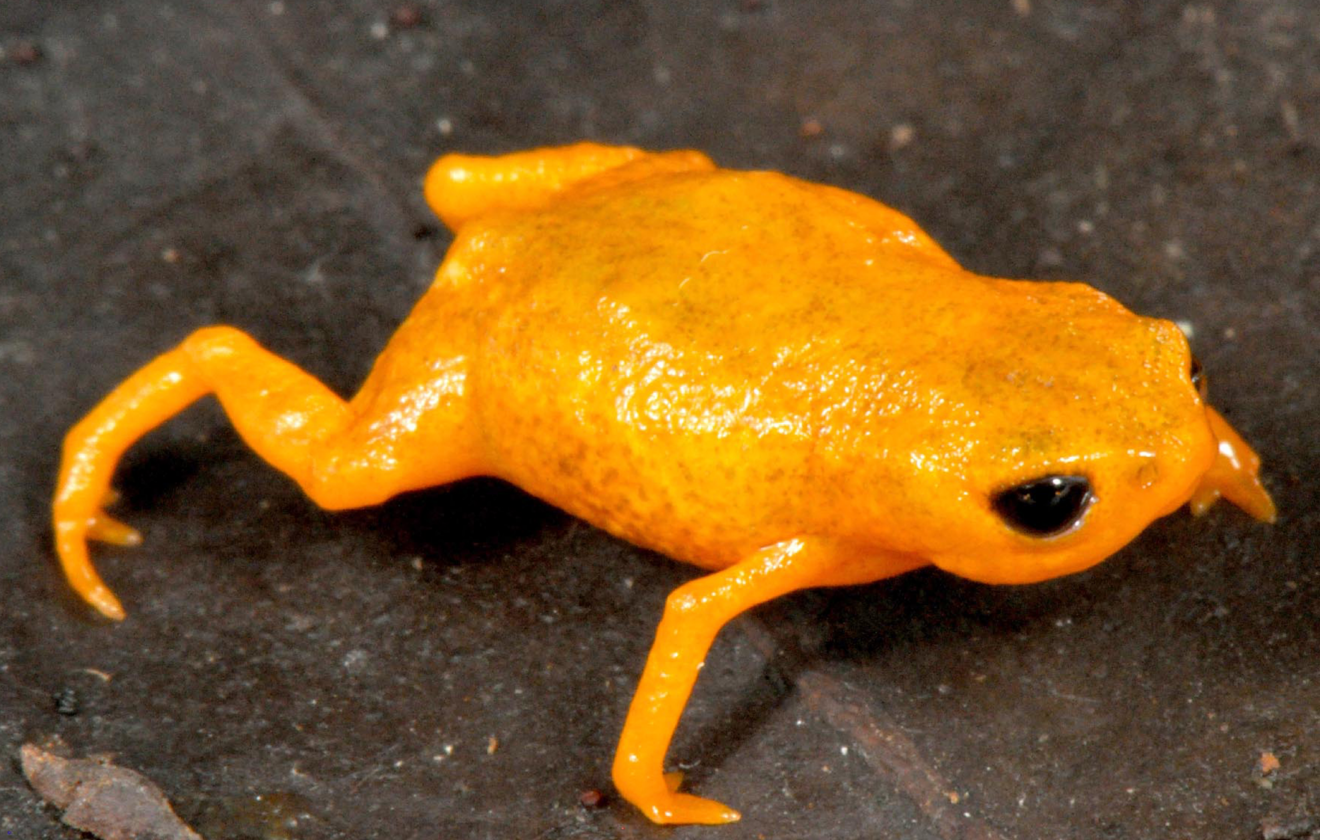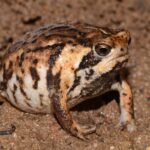Brachycephalus izecksohni: Discovering Brazil’s Little Pumpkin Jewel#
Hidden among the vibrant greens and emerald shadows of Brazil’s Atlantic rainforest lies a tiny, charismatic frog whose presence is as elusive as its beauty is enchanting. Measuring only a few millimeters and dressed in a stunning shade of orange-golden hues, Brachycephalus izecksohni, affectionately known as the “pumpkin toadlet,” embodies the delicate balance and fascinating mysteries woven intricately into one of Earth’s most magnificent biodiversities.
This diminutive amphibian isn’t just an aesthetic marvel; it is also a profound reminder of the critical need to understand, cherish, and protect our natural world. Named in honor of the renowned Brazilian herpetologist Eugenio Izecksohn, Brachycephalus izecksohni offers us remarkable insights into evolutionary adaptations and the fragile interconnectedness of tropical ecosystems.
Taxonomy and Classification#
Brachycephalus izecksohni belongs to the family Brachycephalidae, a group renowned for their remarkably diminutive size and distinctive vibrant colorations. Falling under the genus Brachycephalus, this fascinating species was officially described and recognized by Ribeiro et al. in 2005. Among close relatives, this remarkable species shares the stage with equally captivating froglets such as Brachycephalus ephippium and Brachycephalus voltae, species similarly adapted to niche habitats and possessing notable adaptations.
Its genus, Brachycephalus, itself is intriguing, consisting of some of the smallest vertebrates in the world–tiny amphibians that beckon scientists and nature enthusiasts alike into understanding the evolutionary pressures of miniaturization, vivid coloration, and unique morphological traits that characterize these elusive beings.
Natural Habitat#
Geographic Range and Distribution#
Exclusive to Brazil’s Atlantic Forest biome, Brachycephalus izecksohni is carefully nestled within a limited geographical enclave found in the mountainous regions of southeastern Brazil, primarily inhabiting moist, elevated rainforest locales around 800 to 1200 meters above sea level.
The Atlantic Forest itself is a biodiversity mosaic—an intricate tapestry of life where towering trees adorned by orchids and bromeliads shelter a staggering diversity of creatures, from iridescent birds to elusive mammals. Amid these lush conditions, Brachycephalus izecksohni finds its refuge within the leaf litter blanketing forest floors and among moss-covered boulders, a habitat richly conducive to its specialized survival strategies.
Microhabitat and Ecological Niche#
Life beneath the forest canopy requires unique adaptations. For Brachycephalus izecksohni, thriving amidst leaf litter has led to remarkable refinement of sense and form. These miniature frogs favor areas of dense leaf accumulation and decomposing organic matter, areas teeming with micro-arthropods. The humid, relatively stable conditions and ample invertebrate prey availability form ideal surroundings for this species—conditions perfectly balanced to support their highly specialized behaviors and physiological needs.
Physical Characteristics#
A Jewel-Like Appearance#
Like many members of its genus, Brachycephalus izecksohni astonishes with its jewel-like glow. Averaging a mere 10 to 12 millimeters in length, these amphibians possess stout, rounded bodies, short limbs, and distinctive bright orange or golden coloration. Their vibrant colors, often accented by subtle variations of orange, yellow, or reddish hues, serve critical ecological and evolutionary roles, most notably as aposematic coloration—a warning to potential predators of their toxic skin secretions.
Anatomical Adaptations for Survival#
Notably, the skeleton of Brachycephalus izecksohni has undergone significant evolutionary miniaturization. Fusion of certain bones within the skull and reduction of digits are adaptive results of their extreme, diminutive proportions. These tiny frogs have significantly reduced phalanges in their feet, limiting their grasping abilities but optimizing their efficiency as dwellers of leaf litter—a beautiful demonstration of evolutionary trade-offs.
Behavior and Life Cycle#
Feeding and Foraging Habits#
The forests teem with minute invertebrate life—springtails, mites, small ants, and fly larvae—all nourishing staples in the pumpkin toadlet’s careful diet. These frogs practice a deliberate, patient foraging style. Unlike their more aerobatic amphibian cousins, pumpkin toadlets methodically traverse the forest floor, making brief pauses to snap up tiny prey with lightning precision, using their sticky tongues to ensure each efficient strike results in a meal.
Breeding and Reproductive Strategy#
The life cycle of Brachycephalus izecksohni reveals adaptations that secure survival despite their size limitations. Rather than laying gelatinous egg masses in aquatic environments, females deposit clusters of eggs concealed within humid leaf litter or beneath moss-covered stones on the forest floor. Remarkably, these eggs undergo direct development without a tadpole stage, emerging directly as miniature replicas of their parents—ready to embark upon an autonomous ecological journey.
Ecological Role#
Beyond aesthetic appeal lies an ecological importance that greatly surpasses their minute profile. As integral members of the Atlantic Forest ecosystem, Brachycephalus izecksohni significantly influences insect population dynamics. Its foraging habits mitigate potential outbreaks of various forest-floor pests, subtly maintaining a vital ecological balance. Simultaneously, its brilliant warning colors and toxic skin secretions specifically evolved to deter predators, such as birds and small mammals—driving evolutionarily intricate relationships between predator and prey.
Threats and Conservation Status#
Habitat Loss and Fragmentation#
Though fascinating, Brachycephalus izecksohni faces significant threats tied directly to accelerating habitat destruction. The Atlantic Forest biome—already drastically reduced and fragmented due to agricultural expansion, urbanization, illegal logging, and climate change—remains one of Earth’s most imperiled biodiversity hotspots. With its highly specific habitat needs, even slight habitat perturbation can profoundly impact the viability of local populations.
Conservation Measures and Future Prospects#
The International Union for Conservation of Nature (IUCN) has flagged the urgent need to evaluate and monitor this species closely as part of broader biodiversity protection strategies. Ongoing conservation efforts include habitat restoration, ecological corridor creation, and extensive research studies designed to better understand population health and ecological demands. Citizen science initiatives and community education programs also represent powerful avenues to increase awareness and advocate for habitat protection specific to this species and its unique ecosystem.
Cultural and Scientific Significance#
The intriguing biology and vibrant appearance of Brachycephalus izecksohni have captured numerous scientific interests. This diminutive amphibian epitomizes the complexity of evolutionary forces, from miniaturization and bone fusion to chemical ecology and aposematic coloration. Valuable knowledge derived from studying its toxins also hints at future medical or biochemical applications. Additionally, Brazilian communities view this charismatic tiny creature symbolically as an emblem for nature conservation, highlighting the powerful intersection of ecological and cultural heritage.
Conclusion#
As we spotlight Brachycephalus izecksohni, we also appreciate the intricate interconnectedness of the natural world, highlighting that size often belies environmental significance. Protecting this stunning pumpkin-hued amphibian is far from merely safeguarding one small species—it means preserving a delicate ecological balance, conserving rich biodiversity, and championing the grandeur of our world’s biological wonders. Become captivated, inspired, and transformed into an advocate for protecting our planet’s diminutive yet incredible creatures like Brachycephalus izecksohni.








